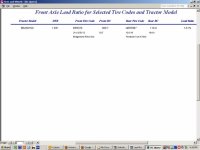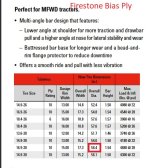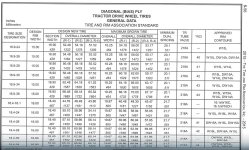Have been looking into replacing rear tires and learning about the importance of Rolling Circumference on a tractors 4wd. To confirm that the tractors current front and rear tires have the correct RC to match the Mechanical Ratio for Lead and Lag, I marked a front and rear tire then drove in 2wd on hard pavement for one full tire rotation. The result was when the front tire turned once, the rear tire was lagging by a lot. The rear tire mark was at about the 2 o'clock position. One interesting thing is when taking the tractor out of 4wd it never feels likes it binding. The lever moves smoothly out of 4wd.
The rear tire is the original 12.4-16 Firestone R1. The front is a Carlisle 6x12 R1. The original front was a Bridgestone that is no longer available. I have spent many hours trying to find what the front tire should be and what the Mechanical Ratio is. I tried Kubota Corporate and they said to work with a dealer. I spoke with a dealer and they had no idea what I was talking about and said to call Corporate. I have also read many threads on multiple forums but can not get a clear answer on what is the correct front tire dimensions.
The front Carlisle tire is 23 inches tall with a RC of 68.9. According to Firestones current specs the rear tire 37.6 inches tall with an RC of 106. However, the tire on the tractor is 30 years old and I have no idea if the dimensions have changed. The tractor only has 650 hours and all on grass so the lugs look great with minimum loss of tire circumference.
I did find a sheet from another forum thread that posted the Mechanical Ratio for a B8200. The B8200 uses the same tires as the B2150 so one would think the mechanical ratio would be the same. When I calculate the lead/lag with my current tires using the B8200 mechanical ratio of 1.691 it calculates a lead of 9.9%.
Lead Lag Calculator
Anyone know what front tire(s) are correct? And the Mechanical Ratio?
The rear tire is the original 12.4-16 Firestone R1. The front is a Carlisle 6x12 R1. The original front was a Bridgestone that is no longer available. I have spent many hours trying to find what the front tire should be and what the Mechanical Ratio is. I tried Kubota Corporate and they said to work with a dealer. I spoke with a dealer and they had no idea what I was talking about and said to call Corporate. I have also read many threads on multiple forums but can not get a clear answer on what is the correct front tire dimensions.
The front Carlisle tire is 23 inches tall with a RC of 68.9. According to Firestones current specs the rear tire 37.6 inches tall with an RC of 106. However, the tire on the tractor is 30 years old and I have no idea if the dimensions have changed. The tractor only has 650 hours and all on grass so the lugs look great with minimum loss of tire circumference.
I did find a sheet from another forum thread that posted the Mechanical Ratio for a B8200. The B8200 uses the same tires as the B2150 so one would think the mechanical ratio would be the same. When I calculate the lead/lag with my current tires using the B8200 mechanical ratio of 1.691 it calculates a lead of 9.9%.
Lead Lag Calculator
Anyone know what front tire(s) are correct? And the Mechanical Ratio?



